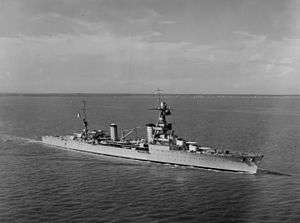French cruiser Suffren
Suffren was a heavy cruiser of the French Navy, the name ship of the four-ship Suffren class. Launched in 1927, she was named for the 18th-century French admiral Pierre André de Suffren de Saint Tropez, becoming the sixth vessel to bear the name Suffren.
 Suffren on 15 October 1931 | |
| History | |
|---|---|
| Name: | Suffren |
| Namesake: | Pierre André de Suffren de Saint Tropez |
| Builder: | Arsenal de Brest |
| Laid down: | 4 April 1926 |
| Launched: | 3 May 1927 |
| Commissioned: | 1 January 1930 |
| Decommissioned: | 1 October 1947 |
| Renamed: | Océan on 1 January 1963 |
| Reclassified: | School ship from 1963 |
| Fate: | Scrapped in 1972 |
| General characteristics | |
| Class and type: | Suffren-class cruiser |
| Displacement: |
|
| Length: | 196 m (643 ft) |
| Beam: | 20 m (66 ft) |
| Draught: | 7.3 m (24 ft) |
| Propulsion: | 3-shaft Rateau-Bretagne SR geared turbines, 9 Guyot boilers, 100,000 shp (75,000 kW) |
| Speed: | 32 knots (59 km/h; 37 mph) |
| Range: | 4500 at 15 knots |
| Complement: | 773 |
| Armament: |
|
| Armour: |
|
| Aircraft carried: | 2 Loire-Nieuport 130 |
| Aviation facilities: | 2 catapults |
Design and description
The design of the Suffren class was derived from the preceding Duquesne class with more armor exchanged for less speed. The ships had an overall length of 194 meters (636 ft 6 in), a beam of 19.26 meters (63 ft 2 in), and a draft of 6.57 meters (21 ft 7 in). They displaced 10,160 metric tons (10,000 long tons) at standard load and 13,135–13,644 t (12,928–13,429 long tons) at deep load. Their crew normally consisted of 647 men and increased by 84 when serving as flagships.[1]
Service history
Onset of war
At the outbreak of the Second World War, Suffren was part of the Force X, under Vice Admiral Godfroy. In early June 1940, at the outset of World War II, the cruisers Suffren, Duquesne, Tourville and Duguay-Trouin, along with three destroyers, operated against the Italian-occupied Dodecanese Islands. Later in that same month, Suffren participated in a joint operation with the Royal Navy - the last such operation before the French surrender to Nazi Germany on 22 June 1940.
Surrender
At the time of the French surrender, Suffren was stationed in Alexandria, Egypt, with other French warships. In contrast to the violent confrontation that took place at the same time at Mers-el-Kébir, Algeria, Suffren surrendered peacefully after the British admiral Andrew Browne Cunningham and the French admiral René-Émile Godfroy reached an agreement. The ship was disarmed and interned by the British on 3 July 1940.
Allied career
Suffren rejoined the Allied cause and was rearmed on 30 May 1943. On 17 July 1943, Suffren rescued survivors of the vessel City of Canton, which was torpedoed off Beira, Mozambique.
Postwar service
Suffren reentered service with the French Navy after World War II. She was wrongly alleged to have participated in the shelling of the Vietnamese port of Haiphong on 23 November 1946, an event that caused over six thousand casualties and contributed to the start of the First Indochina War; three avisos were the actual perpetrators.[2]
On 1 October 1947, after almost twenty years of service, Suffren was decommissioned, and was used as a hulk in Toulon. She was renamed Océan in 1963, and was ultimately broken up in 1974.
References
- Jordan & Moulin, pp. 50, 71–72
- Vaïsse, Maurice (2000). L'Armée française dans la guerre d'Indochine (1946-1954) : Adaptation ou inadaptation. p. 276.